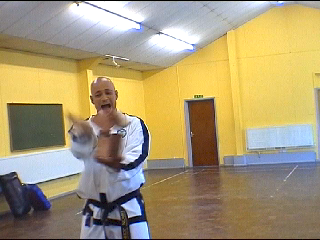Within TaeKwon-Do there is a grading system. You are awarded belts once you have learnt required techniques and theory. This is a good way for the individual to see their progress but it is important to remember that everyone learns at different rates and that some are able to train more than others.
The belts are split into 2 categories: coloured belts, where your grade is referred to as Gup/Kup and then black belts which are referred to as Dan/Degree.
The beginner is referred to as a 10th Gup and wears a white belt.
- • 10th Gup - white belt
- • 9th Gup - white belt with yellow tag
- • 8th Gup - yellow belt
- • 7th Gup - yellow belt with green tag
- • 6th Gup - green belt
- • 5th Gup - green belt with blue tag
- • 4th Gup - blue belt
- • 3rd Gup - blue belt with red tag
- • 2nd Gup - red belt
- • 1st Gup - red belt with black tag
- • 1st - 9th Dan/Degree - black belt
The colour of the belt is also significant, each colour has a relevant meaning that co-incides with the students progress.
White signifies innocence, the beginner who has no knowledge of TaeKwon-Do
Yellow signifies the earth from which a plant sprouts and takes root as the TaeKwon-Do foundation is laid.
Green signifies the plant's growth as TaeKwon-Do skill begins to develop.
Blue signifies the Heaven towards which the plant matures into a tree as training continues.
Red signifies danger, cautioning the student to exercise control and warning the opponent to stay away.
Black signifies the maturity and proficiency in TaeKwon-Do and also indicates the wearer's imperviousness to darkness and fear.
The Interpretation of Patterns
The Interpretation of Patterns
The name of the pattern, the number of movements, and the diagrammatic symbol of each pattern symbolizes either heroic figures in Korean history or instances relating to historical events.
Chon-Ji (19) Chon-Ji means literally the ‘Heaven and Earth’.It is, in the Orient, interpreted as the creation of the world or the beginning of human history, therefore, it is the initial pattern played by the beginner. This pattern consists of two similar parts – one to represent the Heaven and the other the Earth.
Dan-Gun (21) Dan-Gun is named after the holy Dan-Gun, the legendary founder of Korea in the year 2333 B.C.
Do-San (24) Do-San is the pseudonym of the patriot Ahn Ch’ang –Ho (1876 – 1938). The 24 movements refer to his entire life which he devoted to furthering the education of Korea and its independent movement.
Won-Hyo (28) Won-Hyo was the noted monk who introduced Buddhism to the Silla Dynasty in the year 686 A.D.
Yul-Gok (38) Yul-Gok is the pseudonym of a great philosopher and scholar Yi I (1536 – 1584 A.D.) nicknamed the ‘Confucius of Korea’. The 38 movements of this pattern refer to his birthplace on 38’ latitude and the diagram represents ‘scholar’.
Joong-Gun (32) Joong-Gun is named after the patriot An Joong-Gun who assassinated Hiro-Bumi Ito: the first Japanese governor-general of Korea, known as the man who played the leading part of the Korea-Japan merger. There are 32 movements in this pattern to represent Mr. An’s age when he was executed at Lui-Shung prison (1910).
Toi-Gye (37) Toi-Gye is the pen name of the noted scholar Yi hwang (16th A.D.), an authority on neo-confucianism. The 37 movements of this pattern refer to his birthplace on 37’ atitude, the diagram represents ‘scholar’.
Hwa-Rang (29) Hwa-Rang is named after the Hwa-Rang youth group which originated in the Silla Dynasty in the early 7th century. This group eventually became the actual driving force for the unification of the three Kingdoms of Korea. The 29 movements refer to the 29th Infantry Division where TaeKwon-Do developed into maturity.
Choong-Moo (30) Choong-Moo was the given name to the great Admiral Yi Sun-Sin of the Yi Dynasty. He was reputed to have invented the first armoured battleship (kobukson) which was the precursor to the present day submarine in 1592 A.D. The reason why this pattern ends up with a left hand attack is to symbolize his regrettable death having no chance to show his unrestrained potentiality checked by the forced reservation of his loyalty to the king.
Breaking Info
Breaking is part of the program for promotion to each higher level, starting with green belt, and is included in Black Belt competitions.
The goal of breaking is to allow the student to develop self-confidence. Breaking demonstrates that the student has mastered the techniques that allow him or her to produce maximum power.
Power breaking demonstrates technical efficiency, precision, aim, and power.
Special techniques in breaking combine athletic performance with perfect execution of techniques. These techniques include flying techniques and can be spectacular. Height and length of movements are emphasized.
It is very important to practice breaking without hurting oneself. Therefore, thorough preparation is essential.

Senior Master John air break, two bricks
Kicks
Kicks - CHAGI (Attack Techniques-GONG GYOK GI)
Double kick - I-Jung Chagi
The kick delivered twice in succession in the same direction by the same foot.
Triple kick - Samjung Chagi
The kick delivered three times in succession in the same direction by the same foot.
Physical Effects
The study of Taekwon-Do offers several unique advantages to the physical fitness of the student. No doubt one of life's most treasured assets is good health. Therefore, one of the great cardinal sins of mankind is his abuse of this asset. Incidentally, he who does not abuse or hurt his own body, including the hair, is defined as obedient to his parents; so described in Oriental philosophy.
Wealth, power, fame and the blessing of physical beauty are all relatively unimportant if one does not possess good health. An individual owes it to himself and his family to constantly maintain and improve his health. Confucius said "Being in good health is a way of showing great devotion to the parents, as child's heath is their utmost concern." The students will realize how important Taekwon-Do is to human health through the following article written by Dr. Robert S. Arner, a black belt holder of Taekwon-Do.
Preamble

General Choi developed a very complete technical system that has evolved over the years. In the beginning, he used many karate-like movements that were performed rather stiffly. Research by the General and his students, as well as scientific research, led to the current technical system, which continues to evolve.
Taekwon-Do movements respect and work in harmony with the physical laws and the constitution of the human body. This is why practicing Taekwon-Do is excellent for physical growth, overall health, agility, improved co-ordination, and the development of strong mental capacities.
The techniques of Taekwon-Do can be represented as a circle. Each of the individual methods of training is added gradually, building on techniques already learned, but the student continues to practice all the different types of training.
It is necessary to apply the secrets of Taekwon-Do training, as described by General Choi in the Encyclopedia, in order to perform all the ITF Taekwon-Do techniques correctly.
Taekwon-Do is practiced in countries around the world because people appreciate the systematic learning structure offered by the ITF.
International Instructor Courses and other seminars assist ITF Taekwon-Do teachers to improve the quality of their teaching and ensure the uniformity of techniques.
A brief explanation of each of these types of training follows. Detailed illustrated explanations are found in the Encyclopedia of Taekwon-Do.
Explanation of Sin Wave
One of the most important parts of Taekwon-Do is the use of Sine Wave (Hwaldung Pahdo) in almost all of our techniques. We use Sine wave for a number of reasons. It allows us greater power by utilising our body mass effectively and permits greater control over our movements.
Purpose of Patterns
'To perfect fundamental movements'
Historically
Patterns were developed as a result of the strictly enforced law of Hamurabi. This was in effect, "an eye for an eye, a tooth for a tooth". Clearly practicing martial arts was severely limited, as you could not effectively fight a moving opponent. For this reason patterns were developed.
Purpose of Stances
There are many techniques, movements and stances in Taekwon-Do and they all have a particular purpose, and many have more than one. It is very important that you understand what you are doing and why - it is far easier to learn this way knowing and understanding than blindly waving your arms around. Further it also allows you to correct your own mistakes - you can practice on a friend and when you realise that the techniques does not work you can normally see where you are going wrong.
Stances
| Name | Purpose |
|---|---|
| Parallel Stance | This stance is useful for learning new techniques; it also allows the student a moment of contemplation before beginning a pattern/technique. It also allows the student to attack/ defend when there is a limited amount of room for maneuver. |
| Walking Stance | Allows you to attack and to defend to your front and rear quickly and easily. |
| Sitting Stance | Allows you to attack and defend laterally easily. It can also be used for muscle development. |
| L-Stance | Allows you to attack with the front foot quickly (as you do not need to move as much of your body weight) and is also a very maneuverable stance |
| Rear Foot Stance | Allows you to move the front foot spontaneously and accordingly lets you move closer to your opponent quickly, it also allows you to attack with the front foot quickly. |
| Low Stance | Allows you to extend the reach of the attacking tool, it also helps to develop muscles. |
| Bending Ready Stance A | Allows you to be prepared to attack with Side Piercing Kick or Side Thrusting Kick. |
| Bending Ready Stance B | Allows you to be prepared to attack with Back Piercing Kick. |
| X-Stance | This is generally a transitional stance - i.e. for moving from one stance to another or from one spot to another. It is also useful for attacking the side or front in a jumping motion. |
Training Secrets
An old proverb says that even heaven cannot make a diligent worker poor. However, in Taekwon-Do diligence or intensive training alone does not produce quality techniques. On the contrary, instructions from a false or unqualified instructor would be worse than not being taught at all because unscientific movements not only reduce the power but require a tremendous amount of time to correct On the other hand, under the proper guidance of a competent instructor, a student who trains earnestly with dedication will learn the true techniques of Taekwon-Do in a comparatively short period of time with less effort.